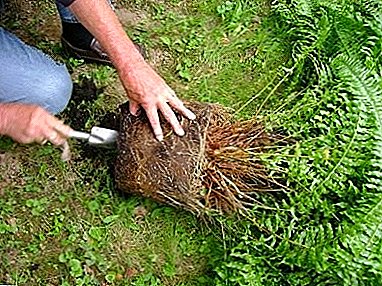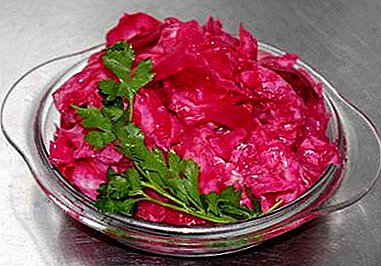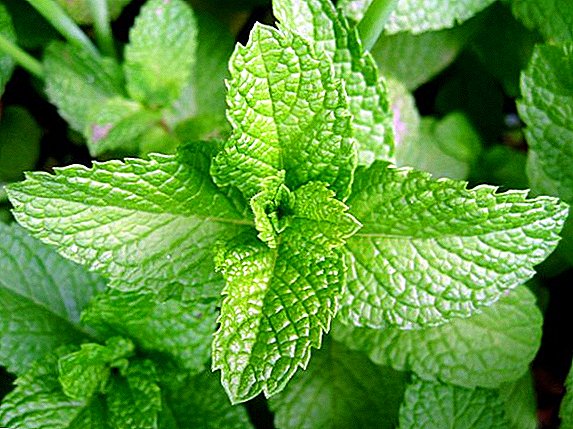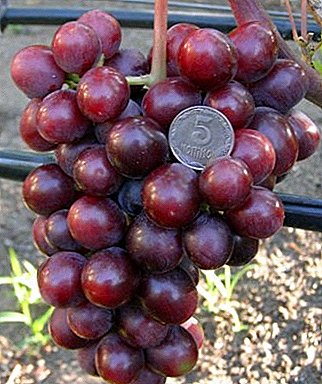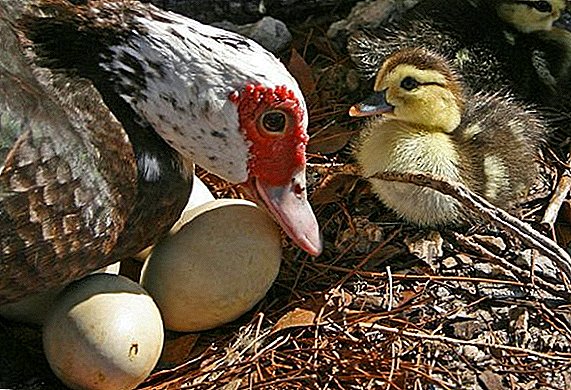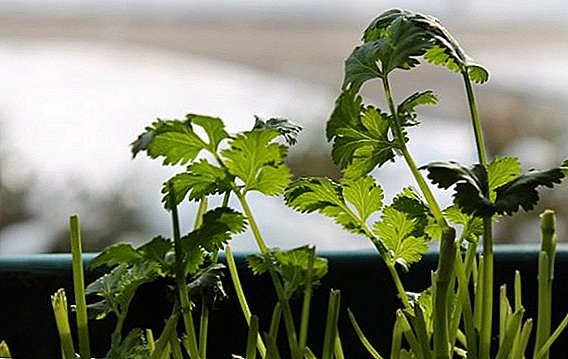 The fact that when planting coriander seeds we get cilantro seedlings is explained by the different names of the parts of the same green spice, as well as the plant itself. This green is also good because it can be grown not only in the garden.
The fact that when planting coriander seeds we get cilantro seedlings is explained by the different names of the parts of the same green spice, as well as the plant itself. This green is also good because it can be grown not only in the garden.
How to get the green mass of cilantro, without leaving your home, on your windowsill - read further in the article.
Characteristic of cilantro plant
Coriander is an annual herb of the umbrella family. Its green part is very similar to parsley and consists of toothed lower and segmented upper leaves.
They contain almost all the vitamins from group B, as well as:
- beta carotene (provitamin A);
- vitamin C;
- tocopherol (E);
- phylloquinone (C).

Mineral component in the form of micro-and macronutrients in cilantro:
- calcium;
- potassium;
- zinc;
- magnesium;
- phosphorus;
- iron;
- copper;
- selenium;
- manganese.
Did you know? In ancient Rome, at the time of Caesar, cilantro was an indispensable ingredient in the daily menu of imperial cuisine. Before the beginning of the meal, the warlords and his guests ate a few leaves of grass to ensure their excellent appetite.
Basic rules for choosing a seed variety
Coriander seeds retain good germination for no more than 2 years, so the fresh they are, the better. A variety for cultivation can be selected based on their preferences.  The most popular varieties on the market today:
The most popular varieties on the market today:
- Stimulus - compact bushes grow up to 30 cm, leaves are dark green in color, ripen in 60 days;
- King of the market - undemanding to heat, greens ripen for 45 days;
- Avant-garde - it is highly resistant to diseases, has a strong and persistent aroma;
- Petrusha gardener - gives juicy and tender leaves, ripens in just 30 days;
- Alekseevsky - has resistance to lowering the temperature, comes to condition for 35 days;
- Oriental flavor - grows up to 60 cm, has strongly flavored leaves, matures for a maximum of 45 days;
- Santo - The height of the bush also reaches 60 cm, and the leaves ripen in 50 days.

What you need to grow cilantro at home
Cultivation of cilantro at home on the windowsill does not pose significant difficulties, but requires compliance with certain rules.
Did you know? Despite the widespread cultivation of cilantro as a cultivated plant, in some botanical circles, such as the British, it is considered to be a weed for its outstanding ability to self-seeding.
Choosing the right tank
When selecting containers for planting cilantro on the windowsill of a house, you must first of all make sure that there are drainage holes in the tank. Coriander, like many other plants, does not like stagnant moisture in the root system. Therefore, it is necessary to place a drainage layer in the container, which may consist of such materials:
- expanded clay;
- small pebbles;
- small crushed stone;
- broken brick;
- pieces of foam.
 Fine kezamzit serves as a good drainage layer for growing cilantro. The shape and size of containers usually depend on the specific sill and method of artificial lighting. It is better to use long trays in the entire window-sill in the presence of elongated fluorescent lamps. If additional light comes from ordinary table lamps, it is best to sow the plant in small round containers.
Fine kezamzit serves as a good drainage layer for growing cilantro. The shape and size of containers usually depend on the specific sill and method of artificial lighting. It is better to use long trays in the entire window-sill in the presence of elongated fluorescent lamps. If additional light comes from ordinary table lamps, it is best to sow the plant in small round containers.Soil preparation
For sowing coriander, a universal substrate is best suited, which is offered in specialized stores for growing indoor plants. In the absence of purchased soil, you can prepare the soil with your own hands. To do this, you need to connect 1 part of sod land, the same amount of humus and half of the river sand.
To guarantee the safety of future plantings in the face of diseases and pests, it is useful to decontaminate the substrate — pour it with a hot 2% solution of potassium permanganate. Also, the land taken from the garden or from the garden, should be ignited in the oven.  Nitrogen is useful for the development of green mass - its plants are best absorbed from organic fertilizers, for example, from the same humus that is added to the substrate.
Nitrogen is useful for the development of green mass - its plants are best absorbed from organic fertilizers, for example, from the same humus that is added to the substrate.
Important! You should not buy coriander seeds for growing cilantro in grocery stores, because in the process of pre-sale preparation, they are subjected to heat treatment and lose germination.
Seed treatment
Coriander seeds for growing cilantro are recommended to be purchased only in specialized stores. There is a guarantee of freshness of seed material and the absence of infection on it. Soaking coriander seeds to stimulate germination Before sowing, seeds should be soaked in water for a couple of hours to stimulate germination. With the same purpose, sunflower seeds is useful to divide in two.
Soaking coriander seeds to stimulate germination Before sowing, seeds should be soaked in water for a couple of hours to stimulate germination. With the same purpose, sunflower seeds is useful to divide in two.
Detailed landing pattern
Sow the seeds in the substrate should be rows at a depth of a maximum of 1.5 cm, with an interval of 3-4 cm between the seeds and rows. It is better to plant cilantro at once to a permanent place, since the plant is extremely poor in tolerating transplantation.  After sowing, the seeds should be sprinkled with the substrate, irrigated from the dispenser with water at room temperature and covered with a film to create the greenhouse effect.
After sowing, the seeds should be sprinkled with the substrate, irrigated from the dispenser with water at room temperature and covered with a film to create the greenhouse effect.
Video: sowing cilantro for growing on the windowsill
Features care after planting
Although cilantro is an unpretentious plant, it still requires the use of a number of agrotechnical techniques to increase the maximum amount of green mass and saturate it with useful substances. This plant is quite cold-resistant, but at the same time does not tolerate heat. The optimum temperature for its growth is between + 14 ° C and + 20 ° C. The lighting for cilantro is required intensively, from 6 to 10 hours a day - otherwise the grass stems are strongly drawn out and the bushes lose their fluffiness.
We recommend that you familiarize yourself with the features of growing cilantro from seeds.
Fertilizer and watering plants
Experts do not recommend to get involved in feeding coriander. Nitrogen reserves in organic fertilizers, introduced before planting in the form of humus, or in the substrate purchased in the store, is quite enough for the development of lush green mass. If you plan to achieve flowering and seed production, then should be a couple of times a month to feed the plant with complex fertilizers with a predominance of potassium and phosphorus. In the first month of life, the soil around the cilantro plantings should be moistened with a sprayer so that the root system does not erode. In the future, watering can be carried out under the root.  It should be remembered that cilantro equally painfully tolerates both overdrying and over-wetting. The substrate must be always wet, but without stagnant water in the root system. After watering in a quarter of an hour, it is necessary to drain excess water from the pan. Also, after each moisture should loosen the soil to ensure access of oxygen to the roots. In addition, cilantro likes spraying the leaves with water at room temperature at least 3 times a week.
It should be remembered that cilantro equally painfully tolerates both overdrying and over-wetting. The substrate must be always wet, but without stagnant water in the root system. After watering in a quarter of an hour, it is necessary to drain excess water from the pan. Also, after each moisture should loosen the soil to ensure access of oxygen to the roots. In addition, cilantro likes spraying the leaves with water at room temperature at least 3 times a week.
Important! For more dense and lush green cilantro useful to pinch the stalks on the plant.
Ground care
In addition to a balanced irrigation and fertilizing, the soil needs, as already mentioned, loosening after each irrigation. You also need to ensure that it does not appear weeds that take nutrients from cilantro and can spread pathogens.
Providing reliable plant protection
Being a spicy plant, cilantro itself is able to repel most pests. Nevertheless, there are a number of harmful insects that are not afraid of the ethereal odors of this plant. Cilantro suffers from diseases, most often triggered by a violation of its agrotechnical cultivation. 
From diseases
The diseases most commonly affecting this plant are:
- bacteriosis;
- fomoz;
- ramulariasis;
- chalcosporosis;
- rust;
- powdery mildew.
There are many special tools to help fight these diseases, but the situation is complicated by the fact that they need to process the leaves that are intended for food. Diseased cilantro can not be eaten. However, not affected, but the leaves treated with drugs, even after a certain period of time, should not be eaten. Therefore, so that cilantro is not affected by disease, preventive measures are necessary.  Diseased green cilantro can not be eaten
Diseased green cilantro can not be eaten
From pests
Most commonly cilantro is attacked:
- seedlings;
- umbrella moth;
- bed bugs;
- winter scoop;
- wireworm;
- cumin mites.
 As a preventive measure should be:
As a preventive measure should be:- carry out strictly balanced watering, preventing overdrying of the soil or stagnation of water in the root system;
- sow only decontaminated seeds;
- use disinfected substrate;
- remove weeds immediately upon their appearance;
- loosen the soil after each watering;
- Do not allow harmful insects to appear in the house.
Useful tips for growing cilantro on the windowsill
In order to grow aromatic seasoning at home without any problems, you should use the advice of experienced growers:

- Although cilantro has a very negative attitude to transplantation, but if necessary, you can still try to transplant the shoots to a new place, well moisturizing the soil before it, and also trying not to damage the fragile roots.
- No need to cut the first stems and leaves, because they are very necessary for photosynthesis and the subsequent development of the whole plant. It is necessary to wait for the formation of the outlet.
- As a drainage, instead of the materials mentioned above, you can use a synthetic winterizer, which absorbs excess moisture well.
- If the cilantro bush does not remove flower stalks, then, in addition to the slow-motion set of green mass, this leads to the appearance of a not very pleasant smell in the leaves.
- Coriander is extremely negative in its neighborhood with other crops, therefore it is impossible to grow dill and parsley together with cilantro in the same container.
Create on the windowsill a fragrant island of spicy cilantro under the force of almost any person. Growing this culture at home does not take much time and effort, but on the table there will always be fresh and fragrant seasoning.



